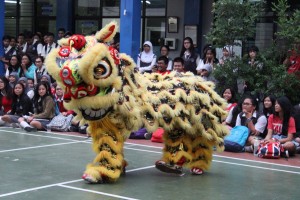Monday, 3rd February 2014
Gong Xie Fat Coi
As we celebrated the Chinese New Year, our school invited a Barongsai (Lion Dance) to SMA Budi Luhur. Students came to watch and enjoy the colourful performance.
Lion dance (simplified Chinese: 舞狮; traditional Chinese: 舞獅; pinyin: wǔshī) is a form of traditional dance in Chinese culture and other Asian countries, in which performers mimic a lion’s movements in a lion costume. The lion dance is usually performed during theChinese New Year and other Chinese traditional, cultural and religious festivals. It may also be performed at many other important occasions such as business opening events, special celebrations or wedding ceremonies, or may be used to honour special guests by the Chinese communities.
The Chinese lion dance is often mistakenly referred to as dragon dance. An easy way to tell the difference is that a lion is normally operated by two dancers, while a dragon needs many people. Also, in a lion dance, the performers’ faces are only seen occasionally, since they are inside the lion. In a dragon dance, the performers’ faces can be easily seen since the dragon is held on poles. Basic Chinese lion dance fundamental movements can be found in most Chinese martial arts.
There are two main forms of the Chinese lion dance, the Northern Lion and the Southern Lion. Both forms are commonly found in China, but around the world especially in South East Asia the Southern Lion predominates as it was spread by the Chinese diasporacommunities who are historically mostly of Southern Chinese origin. Versions of the lion dance are also found in Japan, Korea,Vietnam, and Tibet. Another form of lion dance exists in Indonesian culture, but this is of a different tradition and may be referred to as Singa Barong. – (source: Wikipedia)

